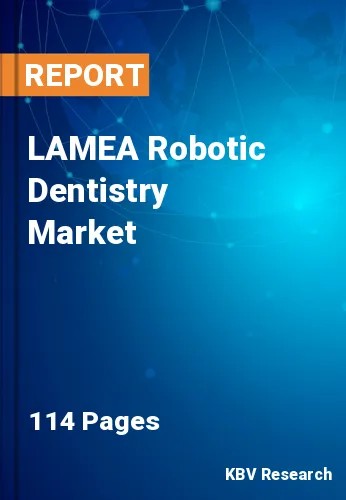The Latin America, Middle East and Africa Robotic Dentistry Market would witness market growth of 20.6% CAGR during the forecast period (2023-2030).
Robotics allows for complete 3D planning, which improves the virtual visualization of important anatomical features. Haptic robotics is used to carry out the plan, which gives physical, optical, and auditory input to direct the surgeon to the required location, angulation, and depth throughout the execution of the digital plan. It is crucial to remember that with robotic implant preparation and placement, the surgeon is physically restricted to drilling at the predetermined position, orientation, and depth while still having the option to change the plan during surgery if necessary. The use of robots in dental clinics, mainly in the tasks of dental assistants, represents one of the most significant arguments for robotic dentistry.
Additionally, one of the most exciting advancements in medical technology is the growing use of automation in many medical processes, notably in diagnostics. Traditional diagnostic methods have a lot of shortcomings despite their moderate effectiveness. Robotic technology in dentistry creates monitoring systems that identify the symptoms of future illnesses or health decline in patients and offer recommendations to clinicians based on these results. It can also examine data from medical records and diagnostic imaging (such as X-rays) to seek patterns that might indicate the presence of a particular problem. This expedites diagnosing, which is essential for complex symptoms with multiple underlying causes.
The largest healthcare industry in Latin America is Brazil, which spends 9.1% of its gross domestic product on healthcare. 63% of the 6,642 hospitals in Brazil are private. There are 532,645 hospital beds, 502,000 physicians, 331,000 dentists, 88,000 healthcare supplementary services, and 89,000 pharmacies as of 2021. At least 70% of Brazil's population receives health services from the Unified Healthcare System (SUS). In addition, the Ministry of Health has been regulating and promoting the expansion of Complementary and Integrative Practices in the public health system, primarily at the municipal level. The growing expenses on healthcare pose lucrative prospects for the market in the LAMEA region.
The Brazil market dominated the LAMEA Robotic Dentistry Market by Country in 2022, and would continue to be a dominant market till 2030; thereby, achieving a market value of $21,482.8 Thousands by 2030.The Argentina market would register a CAGR of 21.3% during (2023 - 2030). Additionally, The UAE market is showcasing a CAGR of 20.3% during (2023 - 2030).
Based on End User, the market is segmented into Dental Hospitals & Clinics, and Dental Academic & Research Institutes. Based on Product & Service, the market is segmented into Robot-assisted system & software, Standalone Robot, and Services. Based on Application, the market is segmented into Implantology, Endodontics, and Others.Based on countries, the market is segmented into Brazil, Argentina, UAE, Saudi Arabia, South Africa, Nigeria, and Rest of LAMEA.
Free Valuable Insights: The Worldwide Robotic Dentistry Market is Projected to reach USD 1.4 Billion by 2030, at a CAGR of 18%
The market research report covers the analysis of key stakeholders of the market. Key companies profiled in the report include Dentsply Sirona, Inc., Dentsply Sirona, Inc., Intuitive Surgical, Inc., Align Technology, Inc., Envista Holdings Corporation, Planmeca Oy, Institut Straumann AG, Amann Girrbach AG (Capvis AG), Vatech Co., Ltd., 3Shape A/S, Titan Surgical Systems.
By End User
By Product & Service
By Application
By Country
Our team of dedicated experts can provide you with attractive expansion opportunities for your business.

